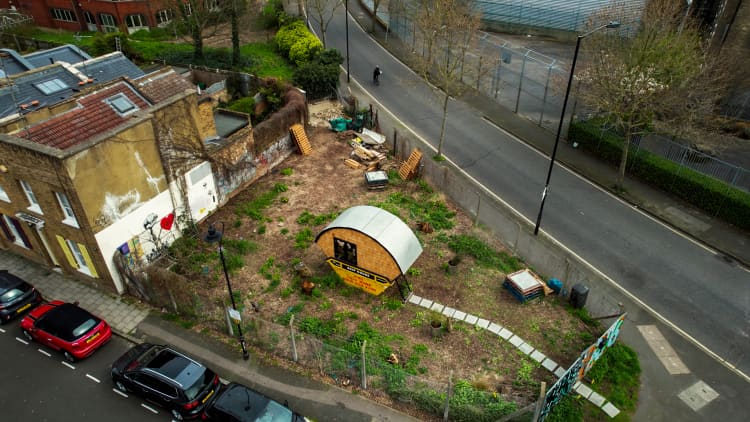In February 2020, I officially got the keys to my new home: a two-bedroom, 796-square-foot Victorian house that I bought for £1.
The sale was part of the “homes for a pound” program created to revive the Webster Triangle, a small run-down area in Liverpool. But there was a catch: the house was in complete disrepair. To qualify, I had to be a first-time homeowner and be able to fix it up within a 12-month period.
The council estimated that the renovations would cost $61,400.
When I applied for the program in 2015, I was a 28-year-old graduate student without much in the way of savings. I didn’t have all the funds I needed, but I submitted my application anyway.
I flipped the configuration of my house so I could maximize natural light. Now the bedrooms are on the first floor, and the kitchen and living area is upstairs.
Photo: Maxine Sharples
By the time I was off the waiting list, my financial situation had changed. I inherited a property from my dad, who had recently passed away, and sold it to get the funds for the renovations.
Today, my house has been remodeled to maximize light and has made headlines in the U.K. for its novel use of space.
Turning my home upside-down
I knew I had my work cut out for me. The house had been abandoned for 15 years. The windows were boarded up, there was a leaky roof, a rat infestation, asbestos, and no power or heating system.
But I loved it. It was my pile of crumbling bricks.
When I started the renovations, there were crumbling bricks everywhere I looked.
Photo: Maxine Sharples
Managing a full renovation isn’t for everyone. Having enough money is only the first hurdle; you need the right people to successfully see things through.
Photo: Maxine Sharples
I realized that I could flip the house’s original layout to get more natural light. So I moved the bedrooms to the first floor, and the kitchen and living room to the second floor. Then I added skylights to the roof.
I paid an architect $1,064 to draw up the blueprints. The contractors I talked to laughed at my proposed reconfiguration of the house. The cheapest quote I got was still $37,600 over my budget, which was the entirety of my savings. But I was undeterred.
In May 2020, at the height of the pandemic, I quit my job as a project officer at a university and started to do the renovations on my own, with limited tools.
Due to the lockdown restrictions, I was granted a 12-month extension. But I was also dealing with joblessness and a breakup. It was clear that I couldn’t do everything alone.
The community that helped me build my urban paradise
I started to blog about the renovation process in August 2021. When I got discouraged, looking back through my Instagram and taking stock of what I actually achieved renewed my vigor.
I’m so grateful for the help of my friends. I know I wouldn’t have been able to finish the project without them.
Photo: Maxine Sharples
This was especially helpful for my resolve, since most of that summer, I was living in a camper van in a local park in Liverpool.
The open kitchen and living area is one of my favorite places in the house. The natural light makes it the perfect spot for my plants to thrive.
Photo: John O’Mahony for CNBC Make It
But with my story, I was able to drive readers to my Instagram account and build a community of followers. Some companies even reached out to offer me discounted products, like 50% off underfloor heating.
In May 2022, after 27 months of work, the house was signed over to me. I was the last homeowner to complete a renovation. I spent a total of $74,000 on labor and materials.
The dining area is now my bedroom. I also replaced the windows with patio doors, giving me direct access into the garden.
Photo: John O’Mahony for CNBC Make It.
Now I pay $119 a month for council tax and $218 a month on utilities, which includes electricity, heat, water, internet and phone bills.
I’m glad I had the conviction and persistence to stick to my vision. I learned how to lay brick, tile, install underfloor heating and refinish floors, and it saved me a lot of money.
The kitchen island, which I bought used, gives me plenty of space to cook and entertain.
Photo: John O’Mahony for CNBC Make It
Currently, my part-time jobs as a project officer, a yoga teacher, a tutor and an online dominatrix bring in $2,505 a month. I work at a leisurely pace, and I’m able to use that money to slowly decorate the home.
I love using this living space to read and practice yoga.
Photo: Maxine Sharples
This house is now worth much more than what I paid in renovations. A 2-bedroom house on my street recently sold for $137,000. But if I ever decided to leave, I’d only rent it out. I’ve invested too much in this place to sell it.
My utility room is compact, but very useful. I was even able to add a washer and dryer.
Photo: Maxine Sharples
With only one room left to renovate, I am taking my time to finish building my dream home — and happily living in a community that was once destined for rubble.
Maxine Sharples is a yoga teacher and project officer at Liverpool John Moores University. She has a master’s degree in International Business and Chinese, and has spent time living and working abroad in Africa and Asia. She enjoys blogging about her income streams, hiking and DIY design projects. Follow her on Instagram @homesforapound.
Don’t miss:
Want to be smarter and more successful with your money, work & life? Sign up for our new newsletter here


This story originally appeared on CNBC
